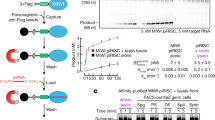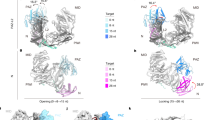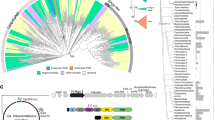Abstract
Genetic, biochemical and structural studies have implicated Argonaute proteins as the catalytic core of the RNAi effector complex, RISC. Here we show that recombinant, human Argonaute2 can combine with a small interfering RNA (siRNA) to form minimal RISC that accurately cleaves substrate RNAs. Recombinant RISC shows many of the properties of RISC purified from human or Drosophila melanogaster cells but also has surprising features. It shows no stimulation by ATP, suggesting that factors promoting product release are missing from the recombinant enzyme. The active site is made up of a unique Asp-Asp-His (DDH) motif. In the RISC reconstitution system, the siRNA 5′ phosphate is important for the stability and the fidelity of the complex but is not essential for the creation of an active enzyme. These studies demonstrate that Argonaute proteins catalyze mRNA cleavage within RISC and provide a source of recombinant enzyme for detailed biochemical studies of the RNAi effector complex.
This is a preview of subscription content, access via your institution
Access options
Subscribe to this journal
Receive 12 print issues and online access
$209.00 per year
only $17.42 per issue
Buy this article
- Purchase on SpringerLink
- Instant access to full article PDF
Prices may be subject to local taxes which are calculated during checkout








Similar content being viewed by others
References
Hannon, G.J. RNA interference. Nature 418, 244–251 (2002).
Martinez, J., Patkaniowska, A., Urlaub, H., Luhrmann, R. & Tuschl, T. Single-stranded antisense siRNAs guide target RNA cleavage in RNAi. Cell 110, 563–574 (2002).
Nykanen, A., Haley, B. & Zamore, P.D. ATP requirements and small interfering RNA structure in the RNA interference pathway. Cell 107, 309–321 (2001).
Lee, Y.S. et al. Distinct roles for Drosophila Dicer-1 and Dicer-2 in the siRNA/miRNA silencing pathways. Cell 117, 69–81 (2004).
Hammond, S.M., Bernstein, E., Beach, D. & Hannon, G.J. An RNA-directed nuclease mediates post-transcriptional gene silencing in Drosophila cells. Nature 404, 293–296 (2000).
Meister, G. et al. Human Argonaute2 mediates RNA cleavage targeted by miRNAs and siRNAs. Mol. Cell 15, 185–197 (2004).
Liu, J. et al. Argonaute2 is the catalytic engine of mammalian RNAi. Science 305, 1437–1441 (2004).
Song, J.J., Smith, S.K., Hannon, G.J. & Joshua-Tor, L. Crystal structure of Argonaute and its implications for RISC slicer activity. Science 305, 1434–1437 (2004).
Parker, J.S., Roe, S.M. & Barford, D. Crystal structure of a PIWI protein suggests mechanisms for siRNA recognition and slicer activity. EMBO J. 23, 4727–4737 (2004).
Martinez, J. & Tuschl, T. RISC is a 5′ phosphomonoester-producing RNA endonuclease. Genes Dev. 18, 975–980 (2004).
Schwarz, D.S., Tomari, Y. & Zamore, P.D. The RNA-induced silencing complex is a Mg2+-dependent endonuclease. Curr. Biol. 14, 787–791 (2004).
Ma, J.B., Ye, K. & Patel, D.J. Structural basis for overhang-specific small interfering RNA recognition by the PAZ domain. Nature 429, 318–322 (2004).
Hockensmith, J.W., Kubasek, W.L., Vorachek, W.R., Evertsz, E.M. & von Hippel, P.H. Laser cross-linking of protein-nucleic acid complexes. Methods Enzymol. 208, 211–236 (1991).
Song, J.J. et al. The crystal structure of the Argonaute2 PAZ domain reveals an RNA binding motif in RNAi effector complexes. Nat. Struct. Biol. 10, 1026–1032 (2003).
Lingel, A., Simon, B., Izaurralde, E. & Sattler, M. Nucleic acid 3′-end recognition by the Argonaute2 PAZ domain. Nat. Struct. Mol. Biol. 11, 576–577 (2004).
Tomari, Y., Matranga, C., Haley, B., Martinez, N. & Zamore, P.D. A protein sensor for siRNA asymmetry. Science 306, 1377–1380 (2004).
Elbashir, S.M., Martinez, J., Patkaniowska, A., Lendeckel, W. & Tuschl, T. Functional anatomy of siRNAs for mediating efficient RNAi in Drosophila melanogaster embryo lysate. EMBO J. 20, 6877–6888 (2001).
Elbashir, S.M., Lendeckel, W. & Tuschl, T. RNA interference is mediated by 21- and 22-nucleotide RNAs. Genes Dev. 15, 188–200 (2001).
Stuckey, J.A. & Dixon, J.E. Crystal structure of a phospholipase D family member. Nat. Struct. Biol. 6, 278–284 (1999).
Gray, C.H., Good, V.M., Tonks, N.K. & Barford, D. The structure of the cell cycle protein Cdc14 reveals a proline-directed protein phosphatase. EMBO J. 22, 3524–3535 (2003).
Cox, D.N. et al. A novel class of evolutionarily conserved genes defined by piwi are essential for stem cell self-renewal. Genes Dev. 12, 3715–3727 (1998).
Yang, W. & Steitz, T.A. Recombining the structures of HIV integrase, RuvC and RNase H. Structure 3, 131–134 (1995).
Davies, J.F. 2nd, Hostomska, Z., Hostomsky, Z., Jordan, S.R. & Matthews, D.A. Crystal structure of the ribonuclease H domain of HIV-1 reverse transcriptase. Science 252, 88–95 (1991).
Haruki, M., Tsunaka, Y., Morikawa, M., Iwai, S. & Kanaya, S. Catalysis by Escherichia coli ribonuclease HI is facilitated by a phosphate group of the substrate. Biochemistry 39, 13939–13944 (2000).
Kanaya, S., Oobatake, M. & Liu, Y. Thermal stability of Escherichia coli ribonuclease HI and its active site mutants in the presence and absence of the Mg2+ ion. Proposal of a novel catalytic role for Glu48. J. Biol. Chem. 271, 32729–32736 (1996).
Kanaya, S. & Ikehara, M. Functions and structures of ribonuclease H enzymes. Subcell. Biochem. 24, 377–422 (1995).
Steitz, T.A. & Steitz, J.A. A general two-metal-ion mechanism for catalytic RNA. Proc. Natl. Acad. Sci. USA 90, 6498–6502 (1993).
Beese, L.S. & Steitz, T.A. Structural basis for the 3′-5′ exonuclease activity of Escherichia coli DNA polymerase I: a two metal ion mechanism. EMBO J. 10, 25–33 (1991).
Goedken, E.R. & Marqusee, S. Co-crystal of Escherichia coli RNase HI with Mn2+ ions reveals two divalent metals bound in the active site. J. Biol. Chem. 276, 7266–7271 (2001).
Katayanagi, K., Okumura, M. & Morikawa, K. Crystal structure of Escherichia coli RNase HI in complex with Mg2+ at 2.8 Å resolution: proof for a single Mg(2+)-binding site. Proteins 17, 337–346 (1993).
Chapados, B.R. et al. Structural biochemistry of a type 2 RNase H: RNA primer recognition and removal during DNA replication. J. Mol. Biol. 307, 541–556 (2001).
Klumpp, K. et al. Two-metal ion mechanism of RNA cleavage by HIV RNase H and mechanism-based design of selective HIV RNase H inhibitors. Nucleic Acids Res. 31, 6852–6859 (2003).
Steiniger-White, M., Rayment, I. & Reznikoff, W.S. Structure/function insights into Tn5 transposition. Curr. Opin. Struct. Biol. 14, 50–57 (2004).
Davies, D.R., Goryshin, I.Y., Reznikoff, W.S. & Rayment, I. Three-dimensional structure of the Tn5 synaptic complex transposition intermediate. Science 289, 77–85 (2000).
Steiniger-White, M., Bhasin, A., Lovell, S., Rayment, I. & Reznikoff, W.S. Evidence for “unseen” transposase-DNA contacts. J. Mol. Biol. 322, 971–982 (2002).
Lovell, S., Goryshin, I.Y., Reznikoff, W.R. & Rayment, I. Two-metal active site binding of a Tn5 transposase synaptic complex. Nat. Struct. Biol. 9, 278–281 (2002).
Bujacz, G. et al. Binding of different divalent cations to the active site of avian sarcoma virus integrase and their effects on enzymatic activity. J. Biol. Chem. 272, 18161–18168 (1997).
Peterson, G. & Reznikoff, W. Tn5 transposase active site mutations suggest position of donor backbone DNA in synaptic complex. J. Biol. Chem. 278, 1904–1909 (2003).
Haley, B. & Zamore, P.D. Kinetic analysis of the RNAi enzyme complex. Nat. Struct. Mol. Biol. 11, 599–606 (2004).
Ishizuka, A., Siomi, M.C. & Siomi, H. A Drosophila fragile X protein interacts with components of RNAi and ribosomal proteins. Genes Dev. 16, 2497–2508 (2002).
Tabara, H., Yigit, E., Siomi, H. & Mello, C.C. The dsRNA binding protein RDE-4 interacts with RDE-1, DCR-1, and a DExH-box helicase to direct RNAi in C. elegans. Cell 109, 861–871 (2002).
Tijsterman, M., Ketting, R.F., Okihara, K.L., Sijen, T. & Plasterk, R.H. RNA helicase MUT-14-dependent gene silencing triggered in C. elegans by short antisense RNAs. Science 295, 694–697 (2002).
Tomari, Y. et al. RISC assembly defects in the Drosophila RNAi mutant armitage. Cell 116, 831–841 (2004).
Motamedi, M.R. et al. Two RNAi complexes, RITS and RDRC, physically interact and localize to noncoding centromeric RNAs. Cell 119, 789–802 (2004).
Meister, G. & Tuschl, T. Mechanisms of gene silencing by double-stranded RNA. Nature 431, 343–349 (2004).
Haley, B., Tang, G. & Zamore, P.D. In vitro analysis of RNA interference in Drosophila melanogaster. Methods 30, 330–336 (2003).
Otwinowski, Z. & Minor, W. Processing of X-ray diffraction data collected in oscillation mode. Methods Enzymol. 276, 307–326 (1997).
Jones, T.A. & Kjeldgaard, M. Electron-density map interpretation. Methods Enzymol. 277, 173–208 (1997).
Brünger, A.T. et al. Crystallography & NMR system: a new software suite for macromolecular structure determination. Acta Crystallogr. D 54, 905–921 (1998).
Ryter, J.M. & Schultz, S.C. Molecular basis of double-stranded RNA-protein interactions: structure of a dsRNA-binding domain complexed with dsRNA. EMBO J 17, 7505–7513 (1998).
Esnouf, R.M. An extensively modified version of MolScript that includes greatly enhanced coloring capabilities. J. Mol. Graph. 15, 132–134 (1997).
Bacon, D.J. & Anderson, W.F. A fast algorithm for rendering space-filling molecule pictures. J. Mol. Graph. 6, 219–220 (1988).
Merritt, E.A. & Murphy, M.E.P. Raster3D version 2.0—a program for photorealistic molecular graphics. Acta Crystallogr. D 50, 869–873 (1994).
Acknowledgements
We thank members of the Hannon and Joshua-Tor laboratories for helpful discussions and A. Heroux (X26C) for support with data collection at the National Synchrotron Light Source (NSLS). C. Marsden and S. Smith provided technical support. P. Zamore kindly provided kinetic tutoring. The NSLS is supported by the US Department of Energy, Division of Material Sciences and Division of Chemical Sciences. F.V.R. is a fellow of the Jane Coffin Childs Memorial Fund. J.J.S. is a Bristol-Myers Squibb Predoctoral Fellow. This work was supported in part by a grant from the US National Institutes of Health (G.J.H.) and the Louis Morin Charitable Trust (L.J.).
Author information
Authors and Affiliations
Corresponding authors
Ethics declarations
Competing interests
The authors declare no competing financial interests.
Supplementary information
Supplementary Fig. 1
Slicer activity is intrinsic to recombinant Ago2. (PDF 3987 kb)
Supplementary Fig. 2
The 5′ phosphate contributes to the formation of active RISC. (PDF 704 kb)
Supplementary Fig. 3
Tungstate-binding sites. (PDF 628 kb)
Supplementary Fig. 4
Mn2+-bound PfAgo. (PDF 561 kb)
Supplementary Fig. 5
ATP does not accelerate cleavage by recombinant RISC. (PDF 595 kb)
Supplementary Fig. 6
Kinetic analysis of recombinant RISC. (PDF 917 kb)
Rights and permissions
About this article
Cite this article
Rivas, F., Tolia, N., Song, JJ. et al. Purified Argonaute2 and an siRNA form recombinant human RISC. Nat Struct Mol Biol 12, 340–349 (2005). https://doi.org/10.1038/nsmb918
Received:
Accepted:
Published:
Issue Date:
DOI: https://doi.org/10.1038/nsmb918



